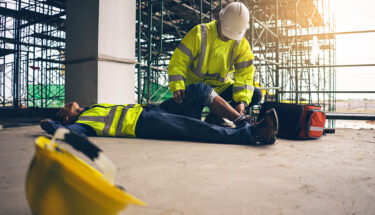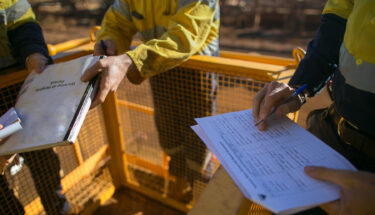First, I hope you’re reading this proactively and not immediately after an incident has occurred. Just as with everything else, incident response takes preparation and planning. There are many things that need to be done, not the least of which is caring for the employee’s medical needs if there was an injury involved. This article should serve as a guide for the things you need to do ahead of time in order to be prepared to properly respond to an incident.
Medical Response
In any given incident with injury to a worker, the most important part of the response will be immediate medical care. Some injuries will require a little first-aid and nothing more. Other injuries could require life-saving first-aid to bridge the time between incident and arrival of emergency medical services. Having people on staff that are properly trained in first-aid/CPR and AED usage is critical. This last one may be the most important of all. Studies show that for each minute a person in cardiac distress goes without defibrillation, they lose an additional 10% chance of survival. Sometimes waiting for 911 to respond isn’t enough.
Knowledge of first-aid/CPR and AED is nothing, however, without the right equipment. Luckily AEDs have come down in price greatly from just a few years ago. Even if you cannot afford one, or if, logistically, buying one doesn’t make sense (for instance, your entire workforce is spread out across a large geographic area), a properly stocked first-aid kit is a must-have.
Finally, know your emergency response. While the 911 network has grown tremendously, there are still plenty of areas where it doesn’t work or where the response comes from further away than other available help. If your work locations change, like in construction, make sure you are doing the proper research to understand what the best local emergency response numbers are. You may need to call a direct line in certain municipalities or the facility you work at may have their own EMS. Once you know the proper number, train your people and make sure it is posted conspicuously.
Investigation
Once the injured employee is taken care of and any dangerous conditions have been controlled (spills have been stopped, power has been cut, machinery has been shut down, etc.), you need to do an investigation. The purpose of this investigation should not be to assign blame, rather it should be to determine what happened, why it happened, and how you can prevent it from happening again. Sure, in certain situations information will come to light that will require disciplinary action, but if that is the main goal of an investigation, you will find it very difficult to get cooperation from the workforce. So how should a proper investigation be conducted?
- Pause work: If the incident was severe enough, your workforce may not be properly focused on the task at hand. This could lead to more injuries. If there was a sever enough injury or fatality, you may need to consider providing counseling services. Either way, an immediate stop of work in the aftermath of a severe incident is a very good decision.
- Secure the scene: Keep everybody out. Get pictures and video immediately. You will need visuals to reference throughout your investigation. Any change made to the scene is a possibility of losing valuable information and insight.
- Interview witnesses: Speak with all of the people involved and the people nearby that had the potential to witness this. It is important to tell people not to guess or assume anything. They should only be telling you the facts of what they saw.
- Collect documentation: Was a JHA performed? What is the procedure? If relevant, is there an SDS? Are there logs or permits? Are there relevant construction drawings or maps? What about user’s manuals or manufacturer’s recommendations? Make sure any paperwork that supports your investigation is included.
- Diagram anything that needs a visual: It doesn’t have to be an AutoCAD drawing, but sketches of the area, placement of equipment, and so on, can be really helpful. Don’t underestimate the power of a good visual. Include any pictures you took.
- Don’t stop there: Once you think you know the reason the incident occurred, push it further. Is that really the root cause? Is an employee’s action really the reason the incident occurred or is their action the result of your failure to properly train them, for example?
- Keep going: Now that you know the root cause, what are you going to do about it? What are the corrective actions? Does a procedure need to be changed? Do additional safety measures need to be implemented? Does new equipment need to be purchased? If so, what is your timeline? Identifying problems and not following through on fixing them can, and most likely will, lead to further incidents.
Case Management
From a financial standpoint, turning your worker’s compensation case over to the insurance company and washing your hands of it is a bad idea. You want to be active in the process. Ensure that employees are making it to their appointments. Discuss your return-to-work policies with the insurance carrier and with the employee (Don’t have any? Develop them). Make sure you are checking in to see how the employee is doing. Employees who feel abandoned after an incident become disgruntled employees. Stay involved to both help the costs from skyrocketing and to make sure your employee is being treated well. Remember, they didn’t intend to get hurt. Even if they did something incorrectly, most likely they were just trying to put food on the table for their family.
Conclusion
Reacting to an incident is exactly what you shouldn’t be doing. If your procedures after an incident takes place are reactionary, you will miss things. Bad injuries could become worse. One could become multiple. First-aids can turn to time away from work. An isolated incident can become frequent occurrences. An easy fix can turn into a wildly expensive, complicated solution. Know what you’re going to do, train your people to do it, have a written plan, execute it, and then, if you have to put it into action, review it to see if it was performed successfully or if changes need to be made. As they say, plan for the worst, then hope for the best.


